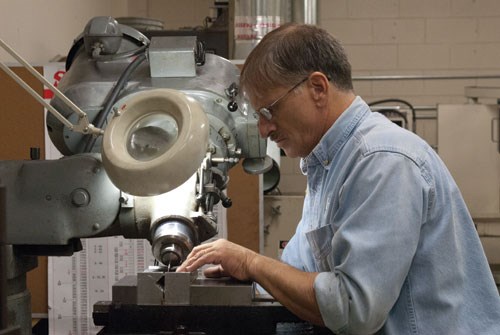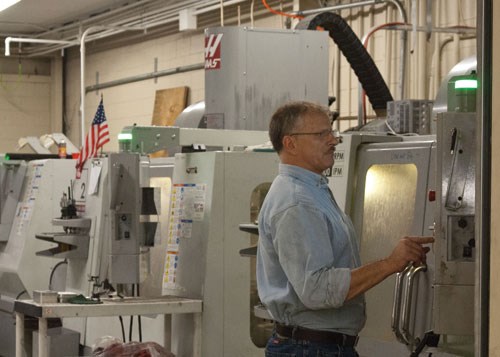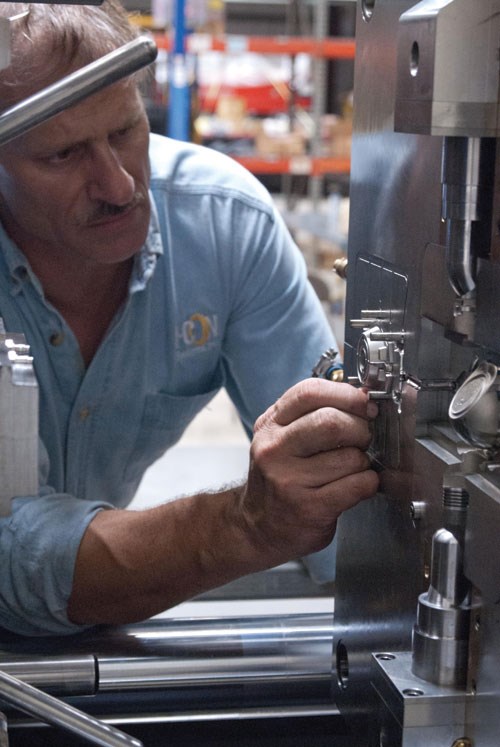Reaping the Rewards of Reshoring
Bringing offshore work back in-house results in streamlined processes, clearer communications and quicker delivery times.
I-CON Systems, Inc. (Oviedo, FL)—a designer and manufacturer of electronic plumbing control systems for commercial and correctional facility customers with in-house engineering, R&D, moldmaking and production operations—had been manufacturing several of its components offshore in an effort to reduce leadtimes and save money. While the company did realize cost savings, a desire to secure patents, make revisions and maintain quality control resulted in a move to make its products in America. Reshoring allowed I-CON to take back quality control and look past the lure of inexpensive labor to examine the true costs of manufacturing a mold.
Examining Costs
Shawn Bush, President, CEO and co-founder of I-CON Systems, explains the company was looking to reshore the entire process—from engineering and design to mold building and injection molding—of its plastic injection molds for its plumbing valves, sensors and other components.
Bush realized that the company needed additional help for this project, so he hired moldmaker James Cardoza and tasked him with beating—or meeting—Asian manufacturing prices.
Cardoza’s extensive background encompassed mold design, multi-axis 3-D programming, manual and CNC machining, and EDM. “James’s background of more than 35 years in machining and moldmaking made him stand out as well as his references,” Bush recalls. “However it was his passion and desire to find the best solution that showed through in the interview and that made the difference to me.”
I-CON set out to examine total costs of outsourcing, such as sourcing costs associated with dealing offshore including trips to Asia to make sure a factory is real and sustainable. “I visited many ‘factories’ that had great prices, but when I went to see them they were in conditions that I could not bet a significant section of our business on their ability to consistently produce quality parts for the long term,” Bush notes. “I also looked at the risks associated with sending funds in advance, examined quality records and costs of rejected parts, as well as trying to get new good parts shipped—sometimes by air freight—to meet customer needs.”
Cardoza’s participated in the design and build aspect of this process. He adds, “Calculating the costs was as simple as determining the associated costs and manpower utilized. This was fed into our accountant’s software and the summary of costs was deemed worthwhile.”
Working with an overseas company had its downfalls, Bush notes. “The molds were quoted and built to the specifications of the vendor,” he elaborates. “Therefore, we were unable to control costs during the mold build process. There were extra costs for revisions, we questioned the steel variations designed by the vendor, cost overruns and delays were an issue, there were quality variations in the machining process, and critical areas necessary for function were usually lost in translation—resulting in rework and unsatisfactory results.” Additionally, I-CON lost ability to control security—and patents.
The Process Begins
Bush notes that the process of re-engineering the molds to make them more automated and easier to build and maintain was a big part of the beginning of reshoring. Here are the steps he took:
• Hiring Cardoza, knowing he could design, program and run the CNCs and manual equipment;
• Purchase the latest software for the shop floor (for I-CON Solidworks/Mastercam);
• Prepare the shop for ease of motion and allow for full accessibility of tooling;
• Purchase import-grade components that will not affect the quality and lifespan of the tool
• Implement semi-automatic production with lathes to help offset the costs of extra manpower
• Purchase expendable tooling as needs suggest, i.e. don’t use an SGS cutter when one of the regrinds will do just fine.
• Make sure all employees possess a concise understanding of the importance of reshoring
• Try not to overthink the process, time is better spent cutting chips;
• Always design with the ease of automation, don’t use traditional methods such as grinding and burning. Instead, use form tools, high speed/high feed and definitely take advantage of the option of unmanned nightly runs;
• Prepare a daily routine that is ready for the next day’s events;
• Cut well and efficiently. Take time while the machines are running to really dive into a solid and proficient program;
• If the designer doesn’t feel comfortable with a program use the simulation option within the CAM system;
• Consider costs to schedule, i.e. is it cheaper or is it faster to have an outside vendor rough cut your pockets and pillars. For I-Con this has proven to be the case.
The First Project
The first mold was a 1+1 top and body enclosure that measured 18”x27” with multiple shut-offs and slides. Cardoza and Mechanical Engineering Designer Ryan Nottage began the project. Cardoza ordered equipment that included Starret micrometers, Suburban angle plates and Interapid indicators, as well as carts, shelves and cleaning supplies.
“My goal was to compartmentalize all tooling, etc., and provide full access to any and all equipment,” Cardoza explains. “As a singular worker in a 1200 square foot section of I-CON Systems, I would leave all my tools and ancillary equipment out and available. During any set-up, I simply roll the open cart to the machine and initiate set-up with ease.”
Cardoza’s next improvement was to keep the area organized and fully optimized, which he achieved with more carts and white boards. “Writing down details and putting tools back into their original location everyday has been another great success,” he notes.
Cardoza and Nottage completed the mold in approximately three months. According to Bush, the process the I-Con team put into place ensured the mold was ready to be cut right the first time. “The part design was completed in Solidworks, and then we performed flow and mechanical analysis on the model before printing it on our 3-D printer to check every aspect of functionality,” Bush elaborates. “Then it was passed to James to interface Mastercam for mold design and 2- and 3-D programming. This process has allowed our molds to shoot good parts the first time the mold is put on the injection machine—every time thus far. There has been no need for rework or modifications.”
Cardoza notes that while some Asian moldmakers can be “quite impressive,” if all of the maintenance and transportation costs—along with the aformentined challenges—are taken into consideration, he believes that the U.S. can compete. “We cannot simply wave our flag and magically turn our economy around,” he states. “It takes dedication from everyone and we must work harder than we used to. If a bolt hits the floor put it away. If you can save 10 percent on buying supplies, do it.”
Nottage weighs in on the benefits of having the entire process done in-house. “As the product designer, I find it much easier to work with a moldmaker who is working under the same roof as opposed to one who is halfway around the world,” Nottage states. “Together, we are able to sit down and review the design in a face-to-face meeting. Revisions to the parts and molds happen so seamlessly with the direct interaction between the two departments. What used to take days now takes minutes to implement. There is also a sense of comfort when you can see and physically touch the tooling that is produced in-house. This way you know what you are truly getting out of the mold shop.”
Efforts Continue
Cardoza and Nottage recently embarked on a new mold package, and are using the lessons they learned with the first one to further streamline operations and reduce costs. “Not only have we been able to meet and beat import tooling, but we enjoy the luxury of in-house tool modifications and revisions,” Cardoza continues. “During a prototype or engineering discovery we find it quite advantageous to go directly to mold. However, with this in mind, there are times during the build that part modifications are necessary.”
Cardoza is able to implement the tooling while engineering does their final touches, during which time engineering makes Cardoza aware of possible revisions while he manipulates the mold design accordingly. “Quite simply, there are times when a mechanical engineer releases his part to the toolmaker and he is not 100 percent satisfied and may want to revise on the fly. With in-house tooling and reshoring, we can simply relay this information to the mold designer and he is able to accommodate for any concerns the engineer may have—and also provide for spatial options within the tool. Conversation and translation is essential at this point and any loss of understanding could place boundaries on a design/build process” explains Cardoza.
He believes that I-CON continues to evolve and reconfigure the mold manufacturing process and the company is well on its way to full optimization. He is looking to further integrate Solidworks into the process to “greatly enhance” current design capabilities. “A simple way of optimizing our tooling is to write a 2-D morph pocket or a spiral routine, then project this toolpath onto a 3-D surface (it is crucial to maintain climb cuts and create faux surfaces to eliminate diving). Then, you end up with a consistent climb cut and full use of the entire flutes. We simply reverse this process for cavity machining,” says Cardoza.
It is also important to design the molds so that the CNC does all the work. “This means cut your shut-offs and contour the insert in the same operation,” Cardoza notes. “You can eliminate costly grinding and manual ops this way.”
Full Circle
Bush is extremely satisfied with his employees’ efforts. “When we considered reshoring, it made us look at the overall costs associated with off shore manufacturing,” he says. “Inexpensive labor offshore is a big draw for any business, but it often comes with added costs of loss in quality, efficiency, timing and control. Prior to our endeavor, we were under the restrictions of distance and cultural understanding. Most of our Asian suppliers are wise and for the most part this wasn’t too much of a problem. However, having an in-house, reshored product allows us to feel more comfortable with liability and concise instruction. Once you have drilled down and make these added costs tangible, the choice to reshore can be truly evaluated.”
According to Cardoza, the first three months were a bit of a bumpy ride. “We were plagued with shop updates and it was essential that we incorporated proper tooling and organization,” he recalls. “The next six months started to show the results. At this point we could see the investment paying off. The last year had its downfalls—but the overall results were golden. Production and molds were incorporated into the shop and it finally has come full circle.” He adds that it is still a work in progress, but thus far mold costs have been within the criteria that sets I-CON’s work apart from import tooling.
The results of I-CON’s reshoring efforts have reached every level of the shop. “We automated our CNC grinders and EDMs,” Cardoza says. “We looked at the entire process and implanted all of the strategies and technologies mentioned earlier to streamline our efforts.” Cardoza adds that the company “didn’t buy the farm all at once; rather, it bought an acre at a time.” I-CON will continue to invest in new equipment.
Additionally, the company ramped up its personnel by 10 through the efforts of HR Director Ryan Cannon. “With today’s economy, there are numerous job seekers,” Cardoza points out. “Ryan selectively sorted through all of the candidates that fit our criteria and put the best people in place.” New positions include people in the mechanical assembly components and maintenance departments, to protect the company’s new investments, Cardoza adds.
And, these people are in constant communication and collaboration. “We continually hone our edge through bi-monthly—or sometimes weekly—meetings that put our minds together to discuss projects in a very calm environment.”
Bush is quick to give credit where credit is due. “The daily collaboration between engineering, moldmakers, marketing and production has allowed us to make a better, more efficient product—on our schedule, with our people,” he says.
I-CON’s “people” have helped the company realize the true benefits of reshoring. There are no more patent or security issues, quality is consistent throughout the entire mold manufacturing process, the company retains full control over tool steel and components choices, and revisions are not lost in translation. Today, Cardoza’s mantra is “Security, dependability and cost containment. Why not buy USA made?”
For More Information
I-CON Systems, Inc. / (407) 365-6241
joaquin.brignoni@i-consystems.com/ i-consystems.com
Related Content
MMT Chats: Mold Builder Shares “Raw and Real” Social Media Strategy
MoldMaking Technology Editorial Director Christina Fuges sits down with Murphy Forsyth, GM – Injection Molding and Director Of Marketing for Zero Tolerance LLC in Clinton Township, MI.
Read MoreMeet New Board Member Murphy Forsyth, Zero Tolerance LLC
MoldMaking Technology's EAB features a new crew of industry professionals. Meet Murphy Forsyth.
Read MoreConnections Fuel Moldmaking Innovation
Trade shows reveal that stepping out of the shop builds connections which drive innovation and success.
Read MoreThe Role of Social Media in Manufacturing
Charles Daniels CFO of Wepco Plastics shares insights on the role of social media in manufacturing, how to improve the “business” side of a small mold shop and continually developing culture.
Read MoreRead Next
Reshoring Initiative Encourages Manufacturers to Bring Jobs Back to US at White House’s Insourcing American Jobs Forum
Founder Harry Moser discusses Total Cost of Ownership as key to understanding real costs of offshoring during expert panel.
Read MoreHow to Use Continuing Education to Remain Competitive in Moldmaking
Continued training helps moldmakers make tooling decisions and properly use the latest cutting tool to efficiently machine high-quality molds.
Read MoreYour Guide to Smarter, Faster Mold Design
Dive into expert-curated content delivering proven solutions for mold optimization, manufacturability and precision performance.
Read More
























